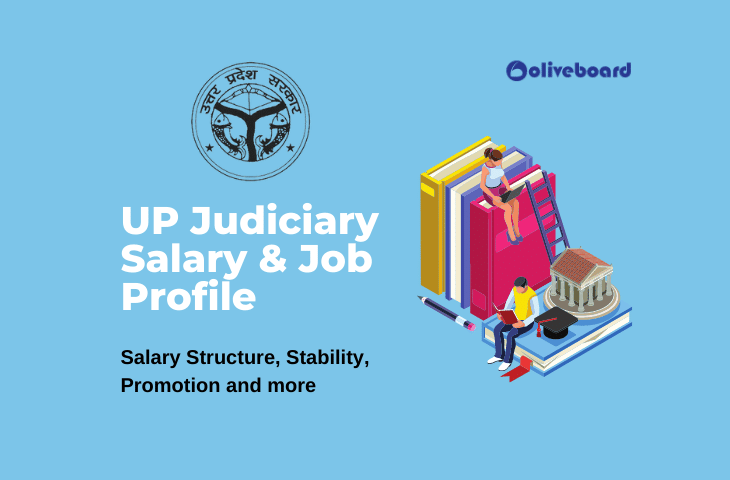The UP-Judiciary Exam, commonly known as the U.P. Judicial Service Civil Judge exam or the UPPSC Civil Judge Exam, is a government recruitment exam held by UPPSC to select applicants for the position of civil judge. The candidates will be chosen based on their overall performance in the Main (written) examination and the interview. Read this article to know all about UP Judiciary Salary and UP Judiciary Job Profile.
The stability and respect that come with working for the government are unrivalled. Among the various forms of government occupations, those associated with judicial services are most highly regarded. The judiciary is regarded as a guardian of Indian democracy and an essential part of society. The majority of UP Judiciary Job Profile pays well and come with a lot of advantages. We will cover the role of a civil judge in this post and the benefits and obligations that come with it.
UP Judiciary Salary Structure 2021
- UP judges are appointed at level 9 of the service category with Rs 56,100 as the grade pay.
- The total salary is Rs 70,000 per month, which comprises the basic pay, dearness allowance (DA) and various other allowances.
- You can expect an NPS deduction on this, lowering your take-home pay to Rs 65,000. The DA for the UP Judiciary Salary is determined at 17 per cent of the base salary, according to UP government statutes.
- While this may not appear to be a large sum, the monetary reward can be increased. When you complete the LLM, your grade pay rises to Rs. 61,300, and your gross salary rises to Rs. 76,000. As a result, passing the LLM final test increases your take-home income to Rs 70,000.
| Qualification | Basic | DA | Gross | Take-Home |
| LLB | Rs. 56,100 | Rs. 9537 | Rs. 70,000 | Rs. 65,000 |
| LLM | Rs 61,300 | Rs 10,421 | Rs. 76,000 | Rs. 70,000 |
UP Judiciary Salary And Perks
Aside from the hefty UP Judiciary Salary, being a Civil Judge in UP comes with many perks. They are provided with free housing, utilities, automobile facilities, and a car maintenance allowance.
Another significant benefit of this Judicial position is the travel stipend for self and dependents. Please keep in mind that not all of these are available during the training period. However, if you complete the program successfully, they will confirm your service, and you will receive all of these benefits.
UP Judiciary Job Profile 2021
Now that you’re aware of the training duration, let’s look at the specifics. You’ll spend the first 15 days of your UP Judiciary Job Profile training in the record room, studying cases. This period will give you an idea of what to expect from your new work. You will have access to be a part of the court audience and see its proceedings for the following 45 days.
The following three months are critical in your judicial preparation. You will attend phase I of classroom training at Lucknow’s reputed Judicial Training and Research Institute. The workshops will be led by renowned lawyers, law professors, and former judges to prepare you for the legal adventure ahead.
You will return to your home court following the classroom training. You will be assigned to a senior judge for the next 6 to 7 months. You’ll be asked to support them and learn new abilities on the job.
For the next three months, you’ll return to Lucknow’s Judicial Training and Research Institute for the second phase of classroom instruction. You will fine-tune your talents and prepare yourself for the responsibilities that await you at this stage. Over the next nine months, you’ll start to preside over cases on your own.
UP Judicial Job Stability And Promotion
One of the several opportunities is a career as a civil judge. The first assignment is as an Additional Civil Judge in the Junior Division or as a Judicial Magistrate. While the two positions in the judicial hierarchy are identical, civil judges will only hear civil cases. Judicial magistrates will hear any criminal case.
Professionals who begin their careers as Judicial Magistrates will advance to the Additional Chief Judicial Magistrate (ACJM) position. Civil Judges in the Junior Division will be elevated to Additional Civil Judge (Senior Division). In all circumstances, the next step up is to Chief Judicial Magistrate (CJM).
CJMs who excel in their jobs are promoted to Additional District and Session Judge. The office of District and Session Judge is the final promotion. Understand that with each promotion, the income and other benefits linked with the position increase significantly. Judges in the state of Uttar Pradesh retire at the age of 60. Some of the best District and Session Judges, on the other hand, make their way to the High Court, where the retirement age is 62 years.
Conclusion
The Uttar Pradesh Public Service Commission is in charge of finding qualified applicants for the position of civil judge in the state. I hope this article has helped you know all about the UP Judiciary Salary and UP Judiciary Job Profile. If you have any further doubts or need clarifications, please reach out to us here at Oliveboard.
FAQs
Civil judges are typically rotated every three months. This schedule may be extended in extraordinary circumstances. While you should expect a lot of transfers over your tenure, they will mostly be in the state’s urban areas.
The cumulative limit stays the same at Rs. 5000, regardless of whether you are an LLB or an LLM.
Several utility expenditures, such as phone, energy, and water bills, are paid to civil judges.
- Bail in Case of Non-Bailable Offence
- Important Judgements For Judicial Services Examination
- Article 21: Important Judicial Decisions On Different Dimensions Of Article 21
- UP Judiciary Salary & Job Profile- Salary Structure, Stability, Promotion
- UP Judiciary Vacancy: Overview, Eligibility Criteria, Application Process
